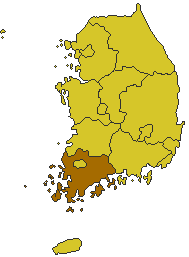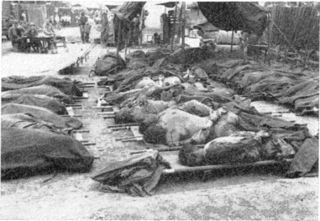Related Research Articles

The Korean War was a war between North Korea and South Korea. The war began on 25 June 1950 when North Korea invaded South Korea.

Syngman Rhee was a South Korean politician who served as the first president of South Korea from 1948 to 1960. Rhee was the first and the last president of the Provisional Government of the Republic of Korea from 1919 to 1925 and 1947 to 1948, and was elected President of South Korea in the 1948 presidential election. Rhee oversaw the transfer of power from the United States Army Military Government in Korea to the Government of South Korea and the establishment of the First Republic of Korea. Rhee adopted a strongly anti-communist and pro-American stance, and led South Korea through the Korean War from 1950 to 1953. He obtained a Bachelor of Arts from George Washington University in 1907, and a Master of Arts from Harvard University in 1908. In 1910, he obtained a Ph.D. from Princeton University.

The Korean conflict is an ongoing conflict based on the division of Korea between North Korea and South Korea, both of which claim to be the sole legitimate government and state of all of Korea. During the Cold War, North Korea was backed by the Soviet Union, China, and its communist allies, while South Korea was backed by the United States and its Western allies. The division of Korea by external powers occurred after World War II had ended, starting in 1945, with the official division in 1948, tensions erupted into the Korean War, which lasted from 1950 to 1953. When the war ended, both countries were devastated, with utter destruction of much of the countries, but the division remained. North and South Korea continued a military standoff, with periodic clashes. The conflict survived the end of the Cold War and continues to this day.

The Division of Korea began at the end of World War II in 1945. With the declaration of the Soviet-Japanese War, the Soviet Union occupied the north of Korea, and the United States occupied the south, with the boundary between their zones being the 38th parallel.

The (Chinese) People's Volunteer Army was the armed expatriate volunteer forces deployed by the People's Republic of China during the Korean War. Although all units in the PVA were actually transferred from the People's Liberation Army under orders of Mao Zedong, the PVA was separately constituted in order to prevent an official war with the United States. The PVA entered Korea on October 19, 1950, and completely withdrew by October 1958. The nominal commander and political commissar of the PVA was Peng Dehuai before the ceasefire agreement in 1953, although both Chen Geng and Deng Hua served as acting commander and commissar after April 1952 due to Peng's illness. The initial units in the PVA included 38th, 39th, 40th, 42nd, 50th, 66th Corps totalling 250,000 men, and eventually about 3 million Chinese civilian and military personnel served in Korea by July 1953.

The 6th Infantry Division was a military formation of the Republic of Korea Army during the 20th Century.

The Bodo League massacre was a massacre and war crime against communists and suspected sympathizers that occurred in the summer of 1950 during the Korean War. Estimates of the death toll vary. Historians and experts on the Korean War estimate that the full total ranges from at least 60,000–110,000 to 200,000. The massacre was wrongly blamed on the communists. For four decades the South Korean government concealed this massacre. Survivors were forbidden by the government from revealing it, under suspicion of being communist sympathizers. Public revelation carried with it the threat of torture and death. During the 1990s and onwards, several corpses were excavated from mass graves, resulting in public awareness of the massacre.

The military history of Australia during the Korean War was very eventful. Japan's defeat in World War II heralded the end to 35 years of Japanese occupation of the Korean Peninsula. The surrender of Japan to the Allied forces on 2 September 1945 led to the peninsula being subsequently divided into North and South Koreas, with the North being occupied by troops from the Soviet Union, and the South, below the 38th Parallel, being occupied by troops from the United States.
South Korea's Truth and Reconciliation Commission, established on December 1, 2005, is a governmental body responsible for investigating incidents in Korean history which occurred from Japan's rule of Korea in 1910 through the end of authoritarian rule in Korea with the election of President Kim Young-sam in 1993.

Yeosu-Suncheon Rebellion, also known as the Yeo-Sun Incident, was a rebellion that began in October 1948 and mostly ended by November of the same year. However, pockets of resistance lasted through to 1957, almost 10 years later.
Anti-communist mass killings are the political mass murders of communists, alleged communists, or their alleged supporters by people, political organizations or governments opposed to communism.

The Battle of Unsan, also known as the Battle of Yunshan, was a series of engagements of the Korean War that took place from 25 October to 4 November 1950 near Unsan, North Pyongan province in present-day North Korea. As part of the People's Republic of China's First Phase Campaign, the People's Volunteer Army (PVA) made repeated attacks against the Republic of Korea Army (ROK) 1st Infantry Division near Unsan beginning on 25 October, in an attempt to take advancing United Nations forces by surprise. In an accidental first encounter with the United States military during the Korean War, the PVA 39th Corps attacked the unprepared US 8th Cavalry Regiment in Unsan on 1 November, resulting in one of the most devastating US losses of the Korean War.

The Hill 303 massacre was a war crime that took place during the opening days of the Korean War on August 17, 1950, on a hill above Waegwan, South Korea. Forty-one United States Army (US) prisoners of war were shot and killed by troops of the North Korean Korean People's Army (KPA) during one of the numerous smaller engagements of the Battle of Pusan Perimeter.

The Sinchon Massacre was an alleged massacre of civilians between 17 October and 7 December 1950, in or near the town of Sinchon. North Korean sources claim the massacre was committed by South Korean military forces under the authorization of the U.S. military and that 30-35,000 people were killed. Other sources dispute the death toll and accuse Korean right-wing security police and communists of the killings. The event allegedly took place during the second phase of the Korean War and the retreat of the DPRK government from Hwanghae Province.
The following lists events that happened during 1950 in the Democratic People's Republic of Korea.
The North Korean occupation of South Korea from June to September, 1950 constituted the first phase of the Korean War.
The Korean War started when North Korea invaded South Korea, and ended on July 27, 1953 with the armistice creating the well-known Korean Demilitarized Zone.

The Battle of Pyongyang was one of the major battles of the United Nations' offensive during the Korean War. Following the Battle of Inchon, the UN forces re-captured Seoul, the capital of South Korea, and proceeded to advance into North Korea. Shortly after advancing, the American and South Korean forces faced the North Korean defenses near Pyongyang, the capital of North Korea, on 17 October.

The Daejeon, or Taejon, massacre was an extrajudicial killings of political prisoners under anti-communist South Korean forces. US officers were present at the time of the slaughter, however it was blamed on the communist North Korean forces in the film "Crime of Korea". Half a century later, the South Korean Truth and Reconciliation Commission investigated what happened in the political violence largely kept hidden from history, unlike the publicized North Korean executions of South Korean rightists.
The UN offensive into North Korea was a large-scale offensive in late 1950 by United Nations (UN) forces against North Korean forces.
References
- ↑ Jager, Sheila Miyoshi. "An Entirely New War." Brothers at War: The Unending Conflict in Korea. New York City, 2013. Print.
- ↑ Li, Xiaobing. "Beijing's Decision." China's Battle for Korea. Bloomington: Indiana UP, 2014. Print.
- ↑ "Seoul After Victory:Reverse Side to South Korean Rule," London Times
- ↑ Letter from Private Duncan to Member of Parliament, National Archiver, Kew, UK
- ↑ https://trove.nla.gov.au/newspaper/page/3783653
- ↑ Jager, 150
- ↑ Jager, 151